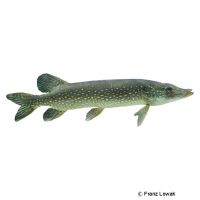Northern Pike (Esox lucius)
| Northern Pike Esox lucius | |
|---|---|
| Name | Northern Pike |
| Name Lat. | Esox lucius |
| Family | Pikes |
| Family lat. | Esocidae |
| Order | Pikes & Mudminnows |
| Order lat. | Esociformes |
| Origin | Europe, Asia, America |
| Habitat | Rivers, lakes |
| Diet | Carnivore |
| pH | 7.0-7.5 |
| Behavior | Predatory, aggressive |
| Keeping | Individual |
| Care Level | Experts only |
| Reproduction | Egg scatterer |
| Breeding | Moderately difficult |
| Life Span | 10-15 years |
| Protection | No |
| Metric Units | |
| Size | 60-100 cm |
| Temperature | 4-28 °C |
| Hardness | 5-10 °dH |
| Aquarium | Pond |
| US Units | |
| Size | 24"-39" |
| Temperature | 39-82 °F |
| Hardness | 89-178 ppm |
| Aquarium | Pond |
Distribution and habitat
Pike are widespread in Europe, except on the Iberian Peninsula, southern Italy and the southern Balkans, in northern and central Asia, and in North America from Alaska to the Great Lakes. They live in the shore region of large, clear lakes and in slow-flowing rivers, where they prefer to live among aquatic plants, in lily pads and in the reed belt.
Maintenance
A very large pond is recommended, which should be furnished with pond, floating and oxygenating underwater plants (milfoil, waterweed, hornwort, etc.), large river pebbles with numerous hiding places and a substrate of round-grained gravel and sand, offering free swimming space.
No ammonia, ammonium or nitrite should be detectable in the water, and the nitrate value should not exceed 100 mg/l. To ensure the water quality and oxygen content, a filter adapted to the water volume is necessary.
Diet
The pike is a lurking hunter that catches its prey with a lightning fast advance. They feed mainly on fish, but frogs, crabs and small mammals are also eaten. The diet consists of insect larvae, fish spawn, worms and live fish according to their size. After habituation, dead (frozen) food fish are also accepted. Dry food is not accepted
Only as much may be fed as is eaten in a few minutes.
Behaviour and compatibility
Pike are loners that are loyal to their location and aggressively defend their territory against conspecifics. Only in sufficiently large ponds can several animals be kept together. A socialization is only possible with large and defensible fish, since every fish that is only slightly smaller comes into consideration as prey
In principle, only mutually compatible fish species with similar demands on water quality and water temperature may be socialized.
Reproduction and breeding
There are no known external distinguishing characteristics of the sexes. The males are smaller than the females.
During the spawning season from March to May, the female spawns in shallow water over plants or flooded meadows. The eggs stick to leaves and branches. The spawning process takes 2-5 days and up to 130,000 eggs are laid per female. After 2-3 weeks, the larvae hatch and swim free after a few days. Males are sexually mature after 2 years, females after 4 years.
Important
If they are overwintered in the pond, ensure sufficient depth and oxygen supply (filter, oxygen dispenser, ice free holder).
At temperatures below 8-10 °C the metabolism of the fish slows down and no more food is accepted, feeding must be stopped accordingly. If the temperature drops further, they hibernate near the bottom. In spring, with rising temperatures, feeding can slowly be resumed. Feeding may also be necessary during prolonged warm periods in winter.
The well-being of the fish should be monitored regularly. A regular partial water change, according to the pond size is recommended, even if the pollutant load has not yet reached the upper limit. Sudden changes in water quality should be avoided. Newly introduced fish must be accustomed to the water slowly
Further literature can be found in your pet store.
References
Text: Werner Winter; Image: Franz Lowak
Source: BMELV (1998): Tierschutzgutachten - Haltung von Zierfischen (Süßwasser); RIEHL & BAENSCH (2006): Aquarien Atlas Bd. 3, Mergus Verlag; ENGELMANN (2005): Zootierhaltung - Tiere in menschlicher Obhut: Fische, Verlag Harri Deutsch
- Gemäß § 21 Abs. 5 Tierschutzgesetz idgF
